Overview
Kong's history began in 1830 when Giuseppe Bonaiti opened the Bonaiti workshop on Lake Como in Lecco, Italy using with an engineering apparatus that was unusual for those times. That plant started producing Bonaiti carabiners in the early 1900s, establishing the Banaiti name in the climbing community. More climbing gear soon followed.
The Bonaiti company reorganized in 1977, adopted the name KONG, moved to the new factory of Monte Marenzo, and installed new machinery. In 1982 the company registered the name and trademark Kong in various countries. Kong continued to include the name Bonaiti on its products for many years.
The company is now managed by a sixth generation Bonaiti. Most Kong products are manufactured inside the Kong factory in Italy. Kong continues to produce carabiners and other tools used for safety in climbing, rescue, caving, yachting and work at height.
Considering their history, I see no reason to separate the Kong-Bonaiti and Kong products by placing them on different
pages.
[ Top
| Kong-Bonaiti, Version B
| Kong-Bonaiti, Version C
| Kong-Bonaiti, Version D
| Kong
| Return to E.C. Ascenders
]
Kong-Bonaiti, Version A
(#9)
Technical Details
I obtained a pair of Kong-Bonaiti ascenders from Bob & Bob
in the summer of 1987.
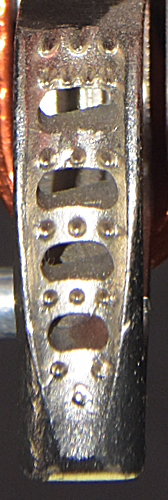 These ascenders are all left-handed.
Each ascender is 117 mm. high, 77 mm. wide, 40 mm.
thick, and weighs 153 grams. The ascender shell is a subtriangular
anodized aluminum stamping 3.8 mm. thick. The rope
channel is formed by bending the right side of the ascender into
a U. The rope channel is 15.5 mm. in diameter. Two indentations
in the stamping extend from the back of the ascender around the
rope channel; these would serve to strengthen the rope channel
against unrolling. The main sling attachment point is located
below the cam and behind the rope channel. A second attachment
point is located above the cam and also behind the rope channel.
The shell is bent backwards at both points to provide clearance
between the attachment slings and the main rope. This accounts
for the rather large thickness of this ascender. The attachment
points appear to be circles distorted by the stamping and bending
operation. The lower attachment point measures 20.5 by 18 mm.
and the upper 18 by 13.5 mm. The left end of the shell is
bent on an inclined axis to form another U. A hole drilled through
both sides of the U accepts a semi-tubular rivet. The cam, cam spring,
and a spacer washer are mounted on this rivet. The head of the
rivet sits into a stamped depression on the back of the cam, while
the roll is exposed on the open side. The pivot is centered 46 mm.
from the inside of the rope channel.
These ascenders are all left-handed.
Each ascender is 117 mm. high, 77 mm. wide, 40 mm.
thick, and weighs 153 grams. The ascender shell is a subtriangular
anodized aluminum stamping 3.8 mm. thick. The rope
channel is formed by bending the right side of the ascender into
a U. The rope channel is 15.5 mm. in diameter. Two indentations
in the stamping extend from the back of the ascender around the
rope channel; these would serve to strengthen the rope channel
against unrolling. The main sling attachment point is located
below the cam and behind the rope channel. A second attachment
point is located above the cam and also behind the rope channel.
The shell is bent backwards at both points to provide clearance
between the attachment slings and the main rope. This accounts
for the rather large thickness of this ascender. The attachment
points appear to be circles distorted by the stamping and bending
operation. The lower attachment point measures 20.5 by 18 mm.
and the upper 18 by 13.5 mm. The left end of the shell is
bent on an inclined axis to form another U. A hole drilled through
both sides of the U accepts a semi-tubular rivet. The cam, cam spring,
and a spacer washer are mounted on this rivet. The head of the
rivet sits into a stamped depression on the back of the cam, while
the roll is exposed on the open side. The pivot is centered 46 mm.
from the inside of the rope channel.
The cam is a skeletonized casting. The cam radius, measured
from the pivot, increases from 38 to 58 mm. over an angle
of 36 degrees. The cam has number of small conical teeth, all
of which have their axes approximately parallel to the upper surface
of the cam. In between the teeth rows are four oval holes which
open to the central vacancy of the cam. The holes and teeth both
decrease in size towards the toe of the ascender. The tooth/hole
pattern is (3.4)(H.3)^3(H.2.1); i.e., a row of 3 teeth, a row
of 4 teeth, three sets of a hole followed by a row of 3 teeth,
a hole, a row of two teeth, and a single tooth. A spring-loaded
manual safety bar is mounted on the bottom of the cam with a somewhat
cracked steel semi-tubular rivet. The normal action of the spring holds
the safety against the cam. When the cam is opened, the shell
interferes with the safety bar, thus preventing opening the cam.
If the safety bar is moved away from the cam (opposing the spring),
it will clear the shell and the cam will open. At full open the
safety can be released and the spring will hold the safety against
the back of the shell. This provides a means of locking the cam
open. A cylindrical knob on the safety bar assists in operating
the safety mechanism.
The back of the shell is stamped "STATIC ROPE," "Ø9
KG. 420," "Ø11 KG. 500," and "KONG-BONAITI-ITALY."
The front of the rope channel is stamped "CAM-CLEAN."
In general I feel that this is a well made ascender. All sharp
edges have been removed. The cam teeth are rather well done, though
not quite as well as some of my older Petzl’s. The shell reinforcing
is a nice touch, though of course I can't quantify its strength
benefit. Similarly, I am unwilling to destroy ascenders to verify
manufacturer’s strength claims, but I am satisfied that this ascender
is strong enough for my own personal use.
The ascender was designed as a chest ascender for the Frog
System, and hence the Kong-Bonaiti is particularly applicable
to this system. According to a letter I received from Kong (dated
26 Jan, 1989), they originally developed his shell shape, and
it was later copied by other manufacturers.
As with most similar ascenders, single-handed operation
of the Kong-Bonaiti is rather difficult, at least when the ascender is free (i.e., not Frog-bound). The better handled ascenders
are much easier to operate free. I find right-handed operation particularly
difficult, as might be expected for a left-handed ascender. Closing
an locked open ascender is much easier than opening, since the
strong cam spring assists the user.
The attachment points are simply holes in the shell, and although
well rounded I consider their small radius too sharp for directly
attaching sling ropes. They are probably acceptably rounded for
webbing, but considering the proximity of the attachment points
to the main rope, I would recommend using a small maillon for
most attachments in order to reduce the risk of sling abrasion.
Orienting the cam teeth parallel to the top of the ascender
cam imparts a slight downwards alignment with respect to the climbing
rope. This increases their grip, reduces tooth friction while
raising the ascender, and provides a small self cleaning action
at the same time. The holes in the cam are intended to reduce
the risk of ascender slippage due to mud-caked cam teeth. This
may be of some benefit under certain caving conditions, particularly
with noncohesive wet silty mud, but my experience is that caves that have
enough mud to clog ascender teeth usually have enough mud to stop
a bulldozer. I suspect that most ropes muddy enough to stop other
ascenders will stop the Kong-Bonaiti too, despite the mud holes.
Although I have not tried this ascender in the appropriate conditions,
I suspect that the holes will not eliminate the icing problems
common to other toothed cam ascenders.
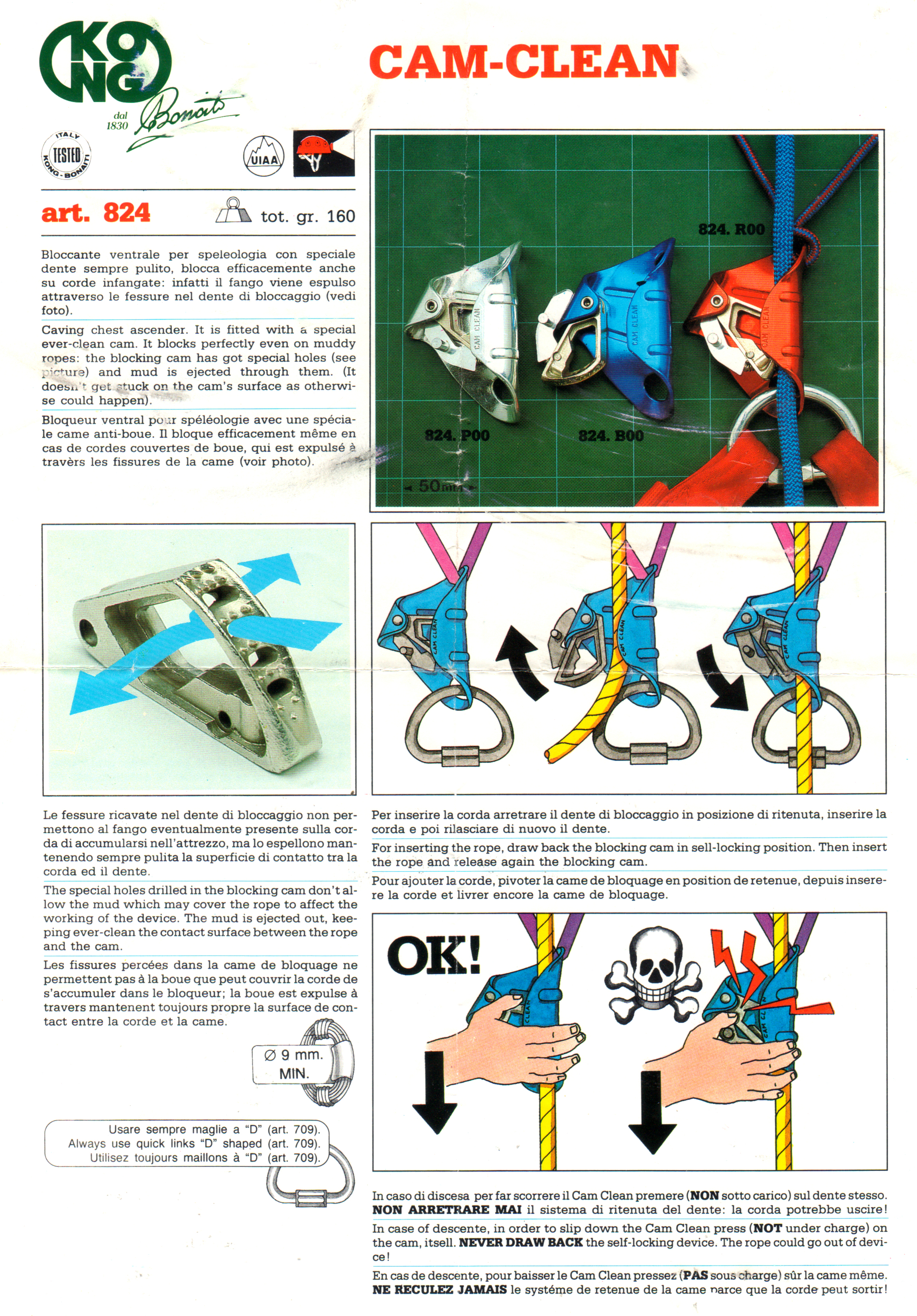 |
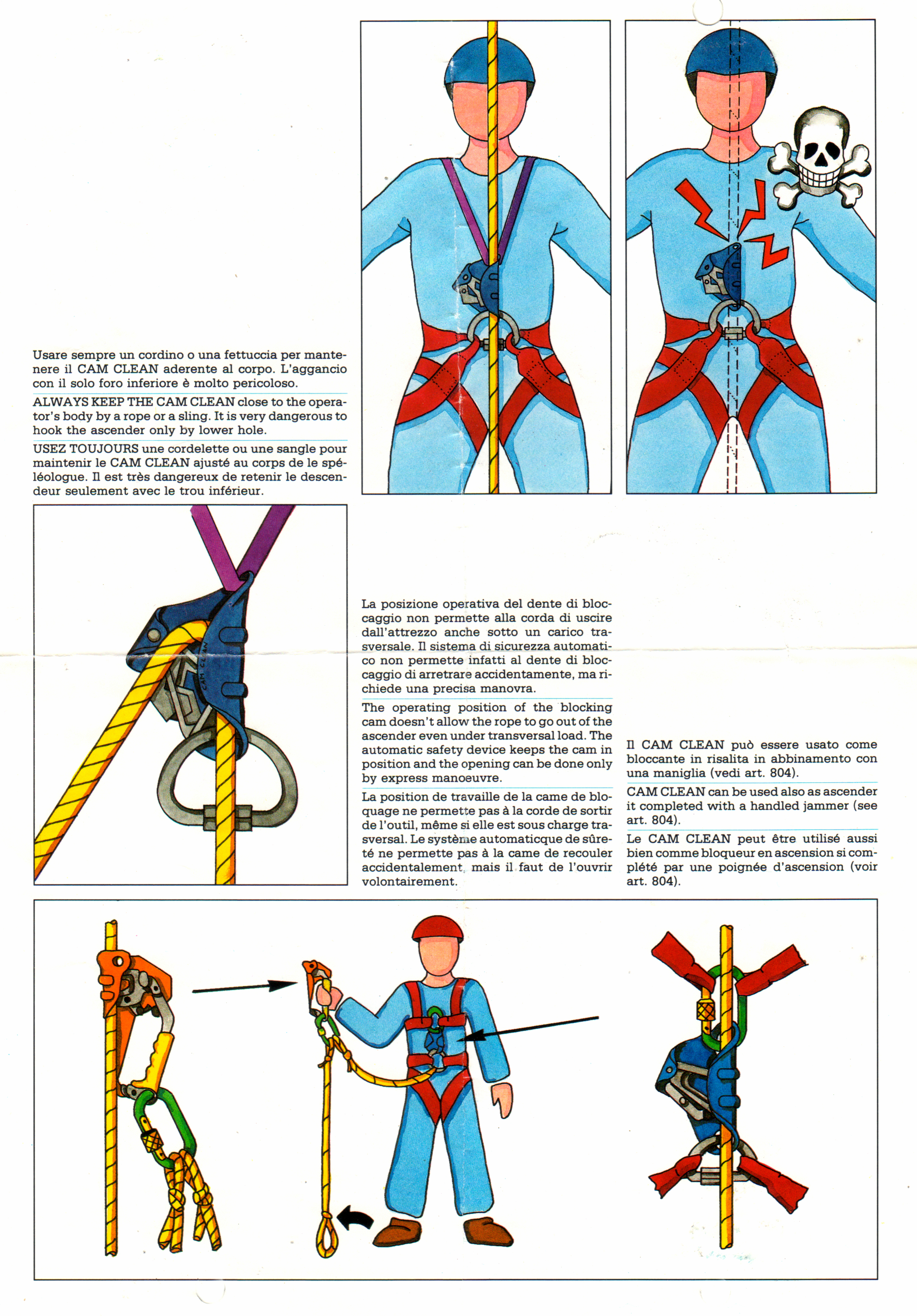 |
[ Top
| Kong-Bonaiti, Version A
| Kong-Bonaiti, Version C
| Kong-Bonaiti, Version D
| Kong
| Return to E.C. Ascenders
]
Kong-Bonaiti, Version B
(#2145)
Technical Details
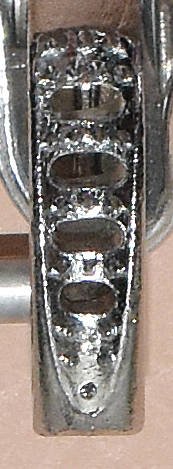 I acquired this ascender in 2017 as part of Bob Thrun’s collection. He bought it in 1994.
I acquired this ascender in 2017 as part of Bob Thrun’s collection. He bought it in 1994.
The Kong-Bonaiti Cam-Clean, Version B is 115 mm. tall, 80 mm. wide, 39 mm. thick, and weighs 152 g.
The shell is the same as on the previous version, except it is clear anodized. According to Bob’s notes, there were three colors available at the time. These would have been plain, red, and blue.
This version has a new cam. The cam radius increases from 38 to 58 mm. over an angle of 42°, giving a 30° cam angle. The tooth pattern was changed to (3)(4.H)^2(3.H)^2(2.2.1) - basically adding a fourth tooth between the top two holes, and a second row of two teeth near the bottom.
The back of the shell is stamped "STATIC ROPE," "Ø9
KG. 420," "Ø11 KG. 500," and "KONG-BONAITI-ITALY."
The front of the rope channel is stamped "CAM-CLEAN."
The extra teeth should increase grip under marginal conditions, but I doubt that anyone would notice the difference - I sure don't.
[ Top
| Kong-Bonaiti, Version A
| Kong-Bonaiti, Version B
| Kong-Bonaiti, Version D
| Kong
| Return to E.C. Ascenders
]
Kong-Bonaiti, Version C
(#3429)
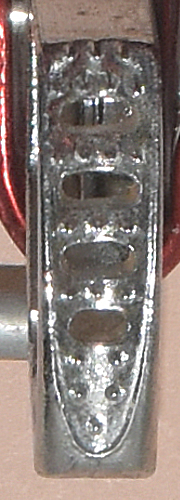 Technical Details
Technical Details
I acquired my Kong-Bonaiti Cam-Clean, Version B from Kristen Ongoy in 2021.
Version C is 115 mm. tall, 80 mm. wide, 39 mm. thick, and weighs 149 g.
The back of the shell is stamped "STATIC ROPE," "Ø9
KG. 420," "Ø11 KG. 500," and "KONG-BONAITI-ITALY."
The front of the rope channel is stamped "CAM-CLEAN."
Version C has colored anodizing; otherwise, it is identical to Version B
[ Top
| Kong-Bonaiti, Version A
| Kong-Bonaiti, Version B
| Kong-Bonaiti, Version C
| Kong
| Return to E.C. Ascenders
]
Kong-Bonaiti, Version D
(#2146)
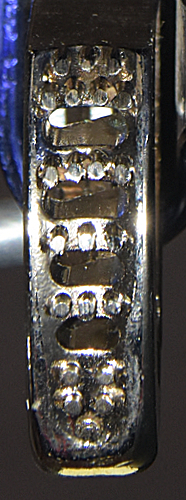 Technical Details
Technical Details
I acquired this ascender in 2017 as part of Bob Thrun’s collection.
The Kong-Bonaiti Cam-Clean, Version D is 115 mm. tall, 80 mm. wide, 40 mm. thick, and weighs 154 g.
The rope channel is printed with "CAM CLEAN" and a rigging illustration. The back of the shell is printed with"KONG-BONAITI-ITALY."
The front of the cam is printed with "CAM-CLEAN," CE0426," <9824632," and "UIAA Ø 8-12 mm."
Version D is functionally identical to Version A.
[ Top
| Kong-Bonaiti, Version A
| Kong-Bonaiti, Version B
| Kong-Bonaiti, Version C
| Kong-Bonaiti, Version D
| Return to E.C. Ascenders
]
Kong
(#2018)
Technical Details
I acquired my Kong Cam Clean from Outdoor Shopping LLC in 2015.
The Kong Cam Clean is 115 mm. tall, 76 mm. wide, 40 mm. thick, and weighs 152 g. It is similar to the Kong, so I'll use the same description in gray, with black text indicating the differences.
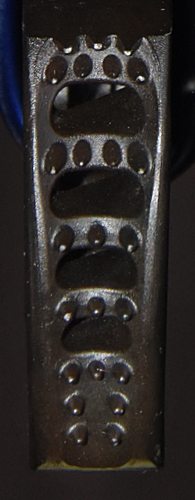 The ascender shell is a subtriangular
blue anodized aluminum stamping 3.4 mm. thick. The rope
channel is formed by bending the right side of the ascender into
a U. The rope channel is 14 mm. in diameter. Two indentations
in the stamping extend from the back of the ascender around the
rope channel; these would serve to strengthen the rope channel
against unrolling. The main sling attachment point is located
below the cam and behind the rope channel. A second attachment
point is located above the cam and also behind the rope channel.
The shell is bent backwards at both points to provide clearance
between the attachment slings and the main rope. This accounts
for the rather large thickness of this ascender. The attachment
points appear to be ovals distorted by the stamping and bending
operation. The lower attachment point measures 21.6 by 17.5 mm. and the upper 19.2 by 13.1 mm. The left end of the shell is
bent on an inclined axis to form another U. A hole drilled through
both sides of the U accepts a semi-tubular rivet. The cam, cam spring,
and a spacer washer are mounted on this rivet. The head of the
rivet sits into a stamped depression on the back of the cam, while
the roll is exposed on the open side. The pivot is centered 45 mm. from the inside of the rope channel. There is a stamped cam stop above the cam.
The ascender shell is a subtriangular
blue anodized aluminum stamping 3.4 mm. thick. The rope
channel is formed by bending the right side of the ascender into
a U. The rope channel is 14 mm. in diameter. Two indentations
in the stamping extend from the back of the ascender around the
rope channel; these would serve to strengthen the rope channel
against unrolling. The main sling attachment point is located
below the cam and behind the rope channel. A second attachment
point is located above the cam and also behind the rope channel.
The shell is bent backwards at both points to provide clearance
between the attachment slings and the main rope. This accounts
for the rather large thickness of this ascender. The attachment
points appear to be ovals distorted by the stamping and bending
operation. The lower attachment point measures 21.6 by 17.5 mm. and the upper 19.2 by 13.1 mm. The left end of the shell is
bent on an inclined axis to form another U. A hole drilled through
both sides of the U accepts a semi-tubular rivet. The cam, cam spring,
and a spacer washer are mounted on this rivet. The head of the
rivet sits into a stamped depression on the back of the cam, while
the roll is exposed on the open side. The pivot is centered 45 mm. from the inside of the rope channel. There is a stamped cam stop above the cam.
The cam is a skeletonized casting. The cam radius, measured
from the pivot, increases from 36 to 57 mm. over an angle of 44°, giving a 30° cam angle. The cam has number of small conical teeth, all
of which have their axes approximately parallel to the upper surface
of the cam. In between the teeth rows are four oval holes which
open to the central vacancy of the cam. The holes and teeth both
decrease in size towards the toe of the ascender. The tooth/hole
pattern is (3)(4.H)^2(3.H)^2(3.2.2). A spring-loaded
manual safety bar is mounted on the bottom of the cam with a steel semi-tubular rivet. The normal action of the spring holds
the safety against the cam. When the cam is opened, the shell
interferes with the safety bar, thus preventing opening the cam.
If the safety bar is moved away from the cam (opposing the spring),
it will clear the shell and the cam will open. At full open the
safety can be released and the spring will hold the safety against
the back of the shell. This provides a means of locking the cam
open. The lower portion of the safety is bent outward to form a thumb tab to assist in operating
the safety mechanism.
The front of the ascender has a sketch of the ascender on an anchored rope, a dashed
up-pointing arrow, and "CAM CLEAN." The rear has the Kong Italy logo, "Made in Italy," the UIAA logo, "CE0426," a book-with-an-"i" icon, EN 567:13, a rope icon, "Ø8÷13 mm," EN 12841:06/B 100kg," another rope icon, "•Ø8÷13 mm," "MEETS NFPA 1983(2012ED)T," "MBS 5 kN," yet another rope icon, "•Ø8÷13 mm," and "142992 14 0078."
|
 |
Warning:
The weight ("100kg") printed on the shell can easily be
less than the weight of a fully loaded caver. |
 |
|
This ascender has barely changed in two decades. I prefer the pin safety, but the tab works as well. The cam stop is neither necessary nor detrimental, and I am indifferent to its presence.
The weight ("100kg") printed on the rear of each ascender can easily be less than the weight of a fully loaded caver. Although I know what this means, American courts may not, so I cannot recommend this ascender for heavier cavers or for expedition caving.
[ Top
| Kong-Bonaiti, Version A
| Kong-Bonaiti, Version B
| Kong-Bonaiti, Version C
| Kong-Bonaiti, Version D
| Kong
]




